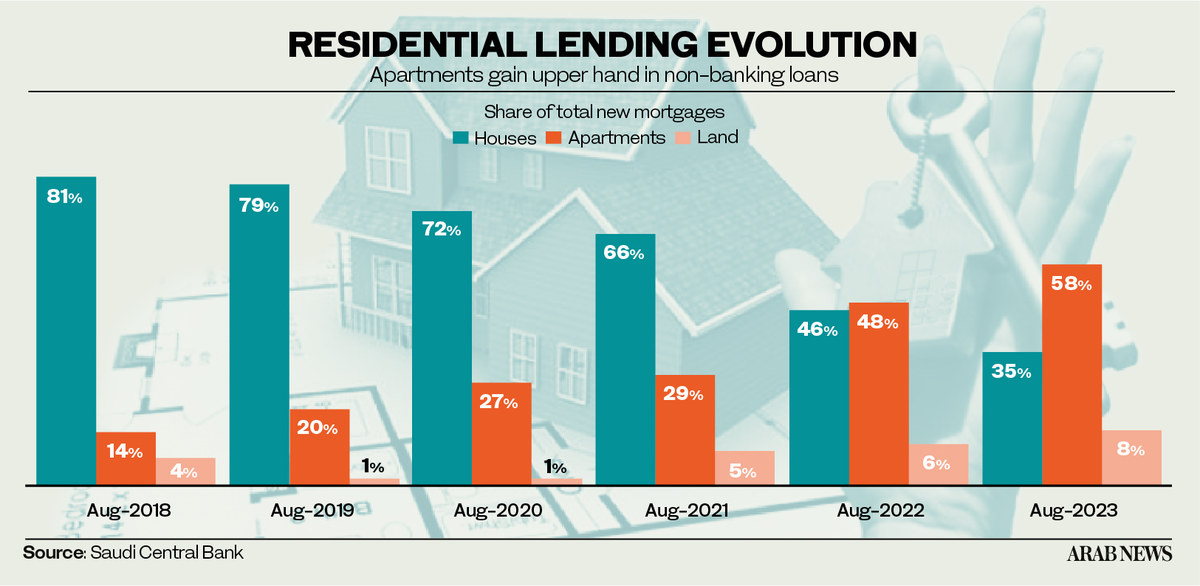RIYADH: Saudi banks’ new residential mortgage lending recorded a 31.7 percent growth in August compared to July, according to the apex bank.
The Saudi Central Bank, also known as SAMA, recently revealed that mortgage lending to houses, apartments and lands rose to SR7.14 billion ($1.9 billion) in August from SR5.43 billion in July.
The remarkable growth observed in apartment lending is particularly intriguing, as the banks injected SR1.78 billion into them in August, reflecting a robust 45 percent surge over July.
This upswing has been especially noteworthy, as it had witnessed a slowdown in the preceding months.
It came at a pivotal juncture, coinciding with the Shoura Council’s call for a review of policies by the Real Estate Development Fund to benefit the public. The implications of these changes are expected to significantly impact the housing market and open new avenues for citizens to fulfill their homeownership dreams.
“The increase in apartment financing by Saudi banks compared to house financing is due to the increase in prices of houses and private villas compared to the prices of apartments, which has made villas and houses unaffordable to average-income individuals,” said Talat Zaki Hafiz, an economist and financial analyst.
New mortgage lending to people buying houses in August also posted a 27.45 percent increment to SR5 billion compared to the earlier month.
Meanwhile, financing for land acquisition recorded a 32.43 percent jump for the month under review to SR399 million.
Notably, financing of houses still dominates Saudi banks’ new residential mortgage landscape, constituting a 70 percent share in August.
While apartments comprised 25 percent of the pie, land financing held the remaining 5 percent.
However, the lending dynamics shift when it comes to finance companies.
In the past, lending for houses held a 70-80 percent share of total new mortgages granted by finance companies.
However, this scenario shifted in July 2021, when this share dipped to 66 percent. This trend continued to evolve, culminating in a significant drop to just 35 percent in August 2023.
Apartment financing now takes the lead among finance companies, commanding a substantial 57.6 percent share of the total new residential mortgage market.
Finance companies channeled SR177 million into apartment financing in August, compared to SR106 million for house financing.
These shifting dynamics suggest a noteworthy change in the lending landscape, highlighting the growing popularity of apartment ownership among Saudi citizens.

The dynamics of lending in the real estate sector, including apartment versus housing lending, can be influenced by various factors and market conditions.
Saudi Arabia has been investing in urban development and city planning. As cities grow and modernize, there may be an emphasis on apartment complexes.
Investment infrastructure and amenities in urban areas can make apartments more attractive to potential homebuyers and renters.
Apartments are often more affordable than single-family houses, making them an attractive option for first-time homebuyers or those with limited budgets.
On the other hand, changes in demographics, such as a growing number of young professionals or expatriate workers in urban areas, may drive demand for apartments, which are often more suitable for smaller households.
According to Hafiz, the growing availability of apartments in the market has made them more accessible to people than purchasing a house.
“Conversely, shifts in lifestyle preferences and a cultural acceptance of apartment living have had a favorable impact on the demand for and desire to live in apartments,” he added.
Furthermore, he added that opting for an apartment over a house can result in cost savings on financing, particularly given the current high-interest rates.
Reforming the housing sector in Saudi Arabia and improving the access of Saudi families to housing that meets their needs is a significant element of the Kingdom’s Vision 2030.
The Vision states: “Housing is the fundamental asset capable of shaping and influencing the vibrancy of families, communities, and broader society.”













